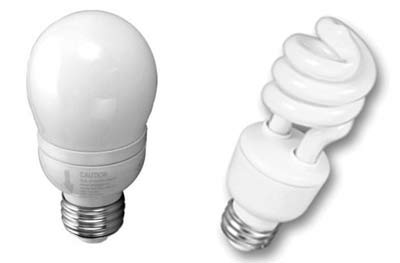'Green' Light Bulbs Pack Toxic Ingredient

Highly efficient fluorescent light bulbs are widely touted as environmentally friendly, but they have created a recycling headache for the EPA and local governments. More often than not, their toxic ingredients simply end up in landfills, where the chemicals can leach into soil and water and poison fish and other wildlife.
The bulbs contain mercury and should not be tossed in the trash like regular light bulbs.
“They’re very efficient, but once they’re used up they become a ticking toxic time bomb," said Leonard Robinson, chief deputy director of the California Department of Toxic Substances Control. "They need to be captured and recycled."
The bulbs remain a good choice for the environmentally conscious, however, because the amount of mercury they contain is less than what is generated in the production of the extra electricity required to light an incandescent bulb.
Few recycling options
Yet while the technology to recycle the fluorescent bulbs exists and some local governments and businesses offer recycling, the programs aren’t widely available.
“There’s not a lot of options out there for recycling them,” said Joe Dunlop, a program coordinator for the Georgia Department of Community Affairs.
Get the world’s most fascinating discoveries delivered straight to your inbox.
The Environmental Protection Agency (EPA) is also working on the problem.
“Though they’re energy-saving, cost-saving, [they] do contain small amounts of mercury, and for that reason, [they] need a little bit more attention in their disposal,” said Joe Bergstein, a spokesman for the EPA's New York City regional office.
“It’s kind of a patchy situation out there,” Bergstein told LiveScience. “Some counties are better budgeted to do these kinds of collections and handle these kinds of materials on a much more regular basis than others.”
Potentially poisonous
Mercury is key to making compact fluorescent light bulbs (CFLs) efficient. Electricity sent through the lamp, which contains mercury vapor and an inert gas such as argon, zaps the mercury, setting off a reaction that creates light. The reaction is more efficient at converting power into light, with less residual heat than a normal incandescent bulb.
Each CFL contains about 5 milligrams of mercury, just enough to cover the tip of a ballpoint pen. By contrast, a mercury thermometer contains 500 milligrams of mercury.
The silvery substance can be dangerous even in small quantities, though, because it can be inhaled or absorbed through the skin, and it damages the central nervous system.
Small amounts can also build up in the environment if the bulbs are thrown in the garbage and break or are incinerated. Mercury can enter the food chain and accumulate, for example, when big fish eat smaller fish that contain mercury, as is already the case with tuna and other large fish.
Don't know, don't care
CFLs need to be taken to a lamp recycler, where the mercury is recovered, processed and sent out to be re-used. But there is no curbside recycling program for these modern bulbs.
Many U.S. counties offer some kind of household hazard waste disposal program, but practices vary regionally; while some have permanent facilities, others have a collection day only once a year.
To recycle a CFL is an expensive prospect, so local governments that offer free disposal do so at their own cost. (Recycling businesses that accept the bulbs tend to charge for the service.)
Adding to the problem is the question of how willing people are to store their used bulbs for a year and then drive to a county facility, or pay to have their bulbs properly disposed of.
“More and more states are starting to ban throwing CFLs away, but on a whole, probably more of these are making it into the trash than are being recycled,” said Robinson, the California official. “The two reasons they’ll toss them: they either don’t know or they don’t care. If we can educate the ones who don’t know, we can pressure the ones who don’t care.”
Diminishing returns
Right now, only 5 to 10 percent of bulbs are being recycled in California. (If you do just throw your CFL away, the EPA recommends double-bagging it in plastic baggies to help keep the mercury from getting out.)
“The recovery rate of these household places is low—who has time on a Saturday to drive 10, 15, 20 miles to recycle? We’re all busy people,” Robinson said. “We’re adding onto the carbon footprint to help protect the environment and it’s just diminishing returns.”
Better accessibility may come down to more businesses getting in on the act and offering to collect used bulbs at their stores. Ikea stores have dedicated kiosks where customers can bring their used lights, regardless of where they were purchased, according to an Ikea spokesperson.
Wal-Mart recently had a collection day at their stores in California, Massachusetts, Rhode Island, Minnesota, and Tulsa. Depending on the consumer response to the event, Wal-Mart may explore making CFL recycling bins a permanent fixture at their stores, said spokeswoman Tara Raddohl.
California is encouraging retail stores and other public places to take the bulbs.
“If recycling centers are where people work, play, shop and worship—we’d get a big collection of these materials,” Robinson said.
As of Feb. 8, 2006, it is actually illegal for California residents to throw CFLs away.
“We’re now engaging the California residents to not put these in the trash,” Robinson said. “If you give people a convenient, local and free option, they’ll choose it over throwing it away, at least in California.”
CFLs still win out
So with the potential for contamination and the currently limited ways to recycle CFLs, should we still use them? Absolutely. As stated above, even if a CFL is thrown in the trash and the mercury it contains leaks out, it still puts less mercury in the environment than a regular, incandescent bulb, according to the EPA.
Though they don’t contain mercury, incandescent bulbs are still lit by electricity, which is often generated by coal-burning plants. Coal actually contains mercury, so when it is burned, mercury is released into the air—about 40 percent of mercury emissions come from coal-burning power plants, according to the EPA.
The EPA has estimated that the mercury in a CFL added to the mercury emitted from the electricity used to power it is still less than the mercury emitted from powering an incandescent bulb. So they’re still the better choice, the EPA's Bergstein says.
“Yes, you’re buying mercury, but it’s a net savings,” Dunlop said in a telephone interview.
Because CFLs are much longer-lived than incandescent bulbs, lasting about 4 to 5 years, there is hope that more options will be available by the time the current generation of bulbs burn out, but for now, the EPA is concentrating on informing the public of the potential danger posed by the bulbs and the current recycling options.
“I think the feeling is that if people were better informed about what is contained in [CFLs], they’d be less inclined to [throw them out],” Bergstein said.
Editor's Note: The EPA has information about buying and disposing of CFLs here. LiveScience staff writer Dave Mosher contributed to this article.
- 10 Ways to Green Your Home
- Top 10 Emerging Environmental Technologies?
- What's Your Environmental Footprint?

Andrea Thompson is an associate editor at Scientific American, where she covers sustainability, energy and the environment. Prior to that, she was a senior writer covering climate science at Climate Central and a reporter and editor at Live Science, where she primarily covered Earth science and the environment. She holds a graduate degree in science health and environmental reporting from New York University, as well as a bachelor of science and and masters of science in atmospheric chemistry from the Georgia Institute of Technology.
